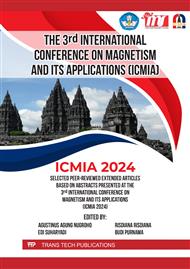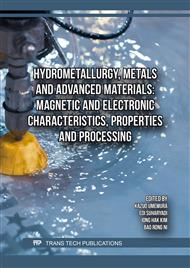p.41
p.53
p.59
p.69
p.77
p.87
p.95
p.105
p.111
Magnetic Study of LiFe(P,Si)O4 Probed by SQUID and µSR
Abstract:
LiFe(P,Si)O4 is a material that belong to parent compound of LiFePO4 widely known as cathode material for lithium-ion battery (LIB). Previous study reports that electrochemical performance of LiFePO4 can be improved by silicon (Si) substitution to the phosphorus (P) site. The sample was obtained via a solid-state synthesis route with the amount of Si doping to the P site is ∼3%. The electrochemical performance of silicon substituted LiFePO4 has been widely studied in other report whilst the magnetic properties is still less explored. Here we investigate the magnetic properties of LiFe(P,Si)O4 using superconducting quantum interference device (SQUID) and muon spin relaxation (µSR). The two measurements display a good agreement result showing two anomalies at the temperature of ∼27 K and ∼52 K that represent the Neel Temperature (ΤN) of Li2FeSiO4 and LiFePO4, respectively. The presence of Li2FeSiO4 that is also a candidate of cathode of LIB has been confirmed by X-ray Diffraction (XRD). Based on the current study, there is no alteration of ΤN on LiFePO4 phase due to Si doping.
Info:
Periodical:
Pages:
105-110
Citation:
Online since:
June 2025
Keywords:
Price:
Сopyright:
© 2025 Trans Tech Publications Ltd. All Rights Reserved
Share:
Citation:



